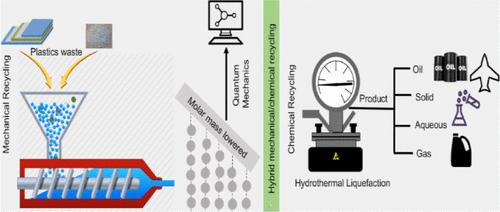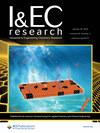Hydrothermal Liquefaction of Post-Consumer Recycled Linear Low-Density Polyethylene with Different Molar Masses in Supercritical Water
IF 3.8
3区 工程技术
Q2 ENGINEERING, CHEMICAL
引用次数: 0
Abstract
Hydrothermal liquefaction (HTL), which uses subcritical and supercritical water as reaction media, was used to chemically deconstruct post-consumer recycled linear low-density polyethylene (PCR-LLDPE) with different molar masses (from 7.20 × 103 to 1.29 × 105 g/mol) into oil at 425 °C for 2 h. When the molar mass was within the range of 7.20 × 103–1.36 × 104 (g/mol), a comparable oil yield (86–90%) was obtained. However, the oil yield was reduced to 66% when the molar mass increased to 1.20 × 105 (g/mol). The chemical compositions of the oil converted from PCR-LLDPE with varying molar masses were mainly composed of paraffins, olefins, cyclics, and aromatics. Additionally, it was found that PCR-LLDPE and the post-HTL solid residues contained metallic impurities that may participate in HTL of LLDPE. The density functional theory was also used to elucidate the role of supercritical water under HTL in aiding deconstruction of LLDPE. The calculated electronic and thermodynamic parameters suggested that alkanes with smaller molar mass require lower energy to be deconstructed in HTL.

不同摩尔质量的消费后回收线性低密度聚乙烯在超临界水中的水热液化
使用亚临界和超临界水作为反应介质的水热液化(HTL)技术,在 425 °C 下将不同摩尔质量(从 7.20 × 103 到 1.29 × 105 g/mol)的消费后回收线性低密度聚乙烯(PCR-LLDPE)化学解构为油,反应时间为 2 小时。当摩尔质量在 7.20 × 103-1.36 × 104 (g/mol) 范围内时,可获得相当的产油量(86-90%)。然而,当摩尔质量增加到 1.20 × 105(克/摩尔)时,产油量降至 66%。不同摩尔质量的 PCR-LLDPE 转化的油的化学成分主要由石蜡、烯烃、环烃和芳烃组成。此外,研究还发现 PCR-LLDPE 和 HTL 后固体残留物中含有金属杂质,这些杂质可能会参与 LLDPE 的 HTL。密度泛函理论还用于阐明 HTL 下超临界水在帮助解构 LLDPE 中的作用。计算得出的电子和热力学参数表明,摩尔质量较小的烷烃在 HTL 中解构所需的能量较低。
本文章由计算机程序翻译,如有差异,请以英文原文为准。
求助全文
约1分钟内获得全文
求助全文
来源期刊

Industrial & Engineering Chemistry Research
工程技术-工程:化工
CiteScore
7.40
自引率
7.10%
发文量
1467
审稿时长
2.8 months
期刊介绍:
ndustrial & Engineering Chemistry, with variations in title and format, has been published since 1909 by the American Chemical Society. Industrial & Engineering Chemistry Research is a weekly publication that reports industrial and academic research in the broad fields of applied chemistry and chemical engineering with special focus on fundamentals, processes, and products.
 求助内容:
求助内容: 应助结果提醒方式:
应助结果提醒方式:


